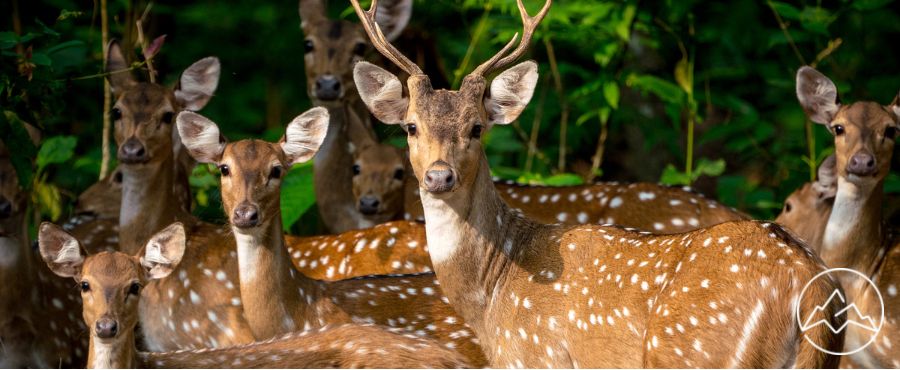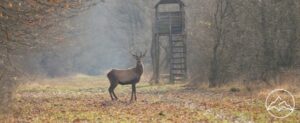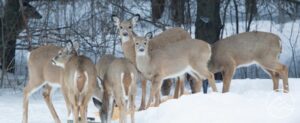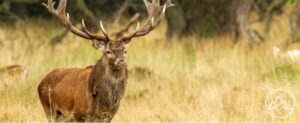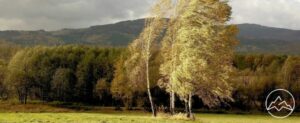You’d be forgiven for thinking all deer are the same, but there are more than 40 species! Including elk, reindeer, red deer, and the famous whitetail, how can you tell the difference? The Cervidae family includes many subspecies; the deer family spans Asia, India, North and South America, and Europe.
Deer hunting is growing in popularity, and deer hunters should know how to identify each species.
Different types of deer
We won’t break down every kind of deer, but we’ll be looking at the most common and distinctive breeds you could come across in North America and beyond, with some facts about each.
Whitetail deer
The whitetail is popular among North American deer hunters. It’s native to the Americas. It’s a medium-sized deer, weighing anywhere from 100lbs to 300lbs or more.
The females can weigh 100-200lbs, and a mature buck can be more than 300lbs. They have reddish-brown coats in the summer and gray/brown winter coats. White tails can be challenging to identify as their coats can change by the season.
Whitetail deer are usually referred to as ‘whitetails’; they earned this moniker due to the white markings beneath their tail. Their tails warn other deers about danger, but it can make it easier for hunters and explorers to distinguish this breed.
Whitetails display unique body language; they’re known for expressing anger with hard looks and antler threats. Male deer (bucks) usually make violent antler contact during the rut (mating season). Fighting usually ends when one deer becomes too tired to continue, but they can occasionally fight to the death. Sometimes bucks become entangled and can’t escape, which can cause the end of one or both. Whitetail deer are highly sought after by bowhunters and rifle hunters.
Blacktail deer
The blacktail is a descendent of mule deer. They’re often found in California and Alaska. A unique black tail can identify blacktails with a white patch underneath.
The blacktail is smaller than mule deer and whitetails, though, like whitetails, they change color with the seasons. Blacktails are easily identified by their expressive ears, broad tails (usually black), and white patch beneath the tail.
Blacktails are usually 130lbs or so but can reach 200lbs+. They might be confused with whitetails if it wasn’t for the distinctive dark antlers with symmetrical branches and stocky bodies. Female blacktails don’t have antlers, but bucks do. Male fawns begin growing antlers at around six months old. Blacktails usually survive on a diet of fungi, nuts, berries, and acorns.
Vampire deer
Vampire deer, or Chinese water deer, are rare because they don’t have any antlers. Their nickname comes from their oversized canine teeth or ‘fangs.’ They are known to be solitary animals.
Thanks to these traits, they are easy to spot, but they have other unique traits, including a very short tail and oversized ears. Their coats are gray/brown. They have brittle fur. They are harmless and can be found often in Siberia and the Himalayas.
Brocket deer
The Brocket deer isn’t very common; they’re usually seen near the Yucatan Peninsula. The word ‘Brocket’ comes from the French word for an immature stag.
It’s no surprise, as this species is very small with smaller antlers. They’re seldom observed in the wild due to being nocturnal, but mated pairs are monogamous for life. They’re usually solitary unless mated. When competing for a mate, the males compete by cashing heads. They stab each other with their tines but can bite, too. There’s no set mating season, but they tend to mate in the autumn.
Mule deer
Mule bucks have white patches on their hips and forked antlers. They’re commonly spotted across the Americas with large ears. A mule deer’s tail usually has a black pattern. You’ll find distinctive white patches on either side, differentiating them from other deer breeds. The mule deer coat is typically gray/brown, making it easier to adapt to desert climates.
Like its white tail cousin, the mule deer is well sought after and ranges from 100lbs to more than 300lbs. Many mule deer can be found in the rocky mountain range.
Red deer
Red deer can range from 100-225lbs and are native to Europe, commonly found in Northern England and the Scottish lowlands, primarily in national parks. It’s one of the most common European deer breeds alongside the Fallow deer.
They can be 4.5ft tall at the shoulder. A male red deer is known as a stag. They have large heads and widely spaced brown eyes. The antlers can be quite ornate and highly branched with multiple points. The branches increase with age. Red deer have unique hoof prints, which can be mistaken for goat prints.
Coues deer
Coues deer are white-tailed deer found in the southern mountains of Arizona, usually during humid and wet summers. Coues can be found in woodlands with plenty of pine, chaparral, and oak. Coues are known for distinctive antlers that curve forward. Coues deer are usually salt and pepper colored with white patches. Their tails are long and broad. Coues deer are small, and fawns stay with their mothers until they mature.
Reindeer
No breed has the reputation that Reindeer, or Caribou, have. They aren’t just a Christmas legend – they’re a real species. The male reindeer is easily identified by its antlers, but they have other distinctive features, including broad hooves, muzzles, and extra-thick fur.
Reindeer are social and travel in large herds, living for around 10-12 years in the wild. They are often found in Scandinavia, the Arctic, Canada, Alaska, and Northern Asia. They are herbivores and usually eat leaves, herbs, moss, and other greenery. Reindeer graze most of the time.
Chital deer
The Chital deer (also known as the spotted deer) has unique features, including white spots. They look similar to whitetail fawn, but their speckled appearance doesn’t change. The speckled spots cover the entire body and span down the legs; they are easy to identify.
The Chital has a long muzzle topped with a dark nose and weighs anywhere from 60lbs upwards, depending on the region. They normally have six-pointed antlers, but they can grow more. The Chital is sometimes called the Axis Deer. They were introduced in Texas, which retains the highest population now. They are usually spotted around glades. They don’t do well in rugged terrain.
Barasingha
The Barasingha, also known as the swamp deer, is an Indian deer breed with populations in several Asian countries. The Barasingha is large with a shoulder height of 4ft. Its fur is wooly, and they are yellow, with its underbelly being white or cream-colored. In summer, the coat may become brownish. Bucks can weigh as much as 600lbs+ and females weigh about half that.
They are excellent swimmers and thrive in rainforests and grasslands.
Elk
Elk came close to extinction during colonial times, but they thrive, particularly in the Western USA. They are usually found in West and Southern Canada. Following reintroduction efforts, the Elk population is relatively high. Elk can reach 9ft tall.
Elk are easy to identify thanks to their copper brown coats, though this can lighten to a tan color during the winter. Elk usually feed on grassy plants though they also eat twigs, forbs, juniper, and berries. They can be killed by cougars, bears, wolves, and coyotes.
Conclusion
If you’re interested in deer or want to take up deer hunting, it’s a great idea to ensure you can identify the most common types of deer. There are a variety of fascinating species of deer, from the whitetail in North America to the Barasingha in South East Asia. If you’re looking to hunt anytime soon, you should pay the closest attention to Elk, Whitetail deer, and Mule deer.

